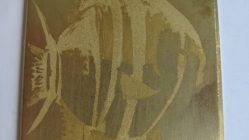Author: Hu Xian (胡宪) Link to the original article in Chinese. Translation in English by: Karen Yu

In 2015, the author paid two visits to the Chinese Quebec artist, Mr. Po Shin Lau, and learned a lot from her ears and eyes. However, this third interview can only be carried out via the WeChat video platform due to the severe epidemic situation, thus limited, resulting a feeling of regret.
The motivation for this interview is to learn that the first batch of donations offered by Po Shin Lau to the Yuyao Museum in his hometown has passed through Canadian customs and is now sailing on a ship bound for China.
Mr. Lau said, “It’s finally done! I left China for almost 60 years, and I don’t remember many things there, but the mountains and rivers of my ancestral hometown of Yuyao are still etched in my mind, even deeper and clearer than my hometown Shanghai.”
In an interview written by the author in 2015, it was mentioned that in 1979, Po Shin Lau, who had just finished his studies in France, flew directly from Paris to Beijing with the dream of serving the country, but in bad luck, he ran into a wall. It was a dream that failed.
Decades have passed, and Professor Lau finally believes that being able to give back to his hometown is just a crazy dream. But he didn’t expect to have a chance to meet a compatriot in a foreign country. During a painting exhibition in Montreal, Professor Lau met the painter Mr. Lihua Zhou (周黎华) and was very happy to learn that the painter Zhou was also from Yuyao and a student of the son of Keran Li (李可染), Xiaoke Li (李小 可). After listening to Professor Lau’s story, the painter Zhou offered to help Professor Lau achieve his dream.

Related to the agreement of receiving the artworks from Po Shin Lau.
Mr. Po Shin Lau:
We have received your donation agreement and donation catalogue (50 etchings, 50 linographs, 50 acrylic paintings, 50 ink wash paintings, 5 watercolour paintings, 50 oil paintings, 10 ex-libris, 6 bas-relief sculptures and some bronze metal sculptures). Thank you for your generous donations toward your native town. Yuyao Museum is willing to receive your artworks donations. Due to your donations, we will be able to expand our museum’s collections. For that we would like to thank you and your family.
Yuyao Museum is a comprehensive museum built in January 2003. In 2010, it has been rebuilt and reopened. Yuyao Museum is occupying about 6000 square feet with more than forty thousand collectible objects. The museum is listed as a national secondary museum. To well accomplish this donation, we will be doing all the necessary preparations. We are looking forward of meeting you and your artworks.
Published by Yuyao Museum
Printed on the 10th of November 2019.
After more than a year of hard work by painter Zhou, the Yuyao Museum and Professor Lau reached an agreement in November of last year. Professor Lau said, “Initially, I had arrangement to return to China in June of this year to participate in the handover ceremony. I also invited some old friends from Shanghai to participate in the commemorative activities. There is also a batch of new works that I was planning to take with me. But those plans have been ruthlessly sidelined by the epidemic. Looking at the current situation, I don’t know if I still have a chance to return to Yuyao in my life…” I hastily interrupted, “There will be a vaccine next year, and the return visa will be released. You must have a chance to go back…”
Professor Lau smiled, “I know my body. Due to diabetes, I cannot see with one of my eyes anymore. I passed out three times this year, and once I slept more than 10 hours before waking up …”
Throughout the video, although Professor Lau needs to move the eyelid of his left eye with his hand to open it, he is still smiling. He told me that as soon as he got dizzy, he immediately drank sugar water to resist it so that he wouldn’t go to the hospital; he told me that “now I run against the clock every day and I have to finish the scheduled work before my right eye goes blind”; he told me that just before the start of the video interview that he was sawing copper plates, and he used the copper plate engraving technique to create a series of miniature seals that merged the aesthetics of East and West. Mr. Lau turned and took the newly cut small block of copper and the design document while showing them to me. : “I still have dreams! I live one day, I work one day!”
Po Shin Lau onscreen has a firm tone and a big smile.

2015 interview article below (with deletions and modifications):
“Chinese painting, oil painting, copper engraving, China, France, Canada – Interview with Chinese Quebec artist Po Shin Lau”
Author: Hu Xian (胡 宪)
Writing about the interview with Po Shin Lau, this title struck me head first. Such a simple statement violates the author’s previous style. But after reflection, these 14 concise and clear words can serve as a guide and let us glimpse at the unusual artistic life of Mr. Po Shin Lau.
From the point of view of his professional career, Mr. Lau learned Chinese painting first, then oil painting followed by copperplate engraving. From the perspective of his life, he laid the foundation of painting in China and achieved his artistic pursuit in France, while in Canada he found a vast open sky to fly between different types of paintings.
Towards the route of art with all my heart
Mr. Po Shin Lau was born in Shanghai in 1941 and his ancestral home is in Zhejiang, Yuyao. Father Zichun Lau (楼 子 春), uncle Weichun Lau (楼 炜 春), and cousin Xichun Lau (楼 锡 春) are all known historical people. Po Shin Lau loved to paint since he was a child and entered the famous Harding Art Studio in Shanghai to study Western painting as a teenager. “But the apprenticeship only lasted three months. When I started to learn more about painting, the government suddenly ordered private art studios in Shanghai to close. Under such circumstances, I found two Chinese painting teachers with whom I studied Chinese painting for a year and finally learned some basic Chinese painting techniques. This foundation of Chinese painting learned during this year has benefited Po Shin Lau for life. Whether he later learned oil painting in Hong Kong, or majored in copperplate engraving at a French art school, the influence of Chinese painting on him is evident.
In 1962, Po Shin Lau took his younger siblings to Hong Kong to reunite with his parents. “My father was a Chinese accountant in a trading exchange company. The salary was low and it was impossible to feed a family of six. Even though I hadn’t really mastered the drawing skills, I wanted to use this little knowledge to make money. At first, I drew cards for the Chinese New Year. Later I helped my father’s friend draw animated films. I worked more than ten hours a day in exchange for a small salary. Life was very difficult. “
Po Shin Lau said, “In order to maintain the painting knowledge I learned in Shanghai and to be able to progress on the technical side, I have to learn on my own. At that time, I often got up at five o’clock, put oil painting tools on my back for carrying, and met Chuong Ki Mui (梅 创 基), Chi Keng Leung (梁德祥) and other painters, in order to take advantage of the early morning to go draw in the countryside. At the same time, I was copying classic oil paintings from the countries of Eastern Europe. I exhibited these works in the window of my family’s small photography studio, and at the same time I took orders for oil paintings from some export companies to paint desperately. This was to not only pay for the cost of buying paint, but also to subsidize the family. This situation lasted for a long time until I left Hong Kong for the first time. “
It should be mentioned that a year before leaving Hong Kong, Po Shin Lau and his painter friend, Chuong Ki Mui (梅 创 基), who later became a wood engraving artist, successfully organized a “Dual Painting Exhibition ”, which can be described as the result of self-taught oil painting.
Paris, the palace of art
“The Paris of France has always been a place that has inspired me. It was my dream to be able to go to Paris to study and learn painting. When my younger siblings could be independent, I know it was time for me to make my dream come true. Very lucky, I got a big painting contract. I was working 16 hours a day and making over 8,000 Hong Kong dollars in a short period of time. After designing movie ads, I applied to go to the French Alliance to learn French, and quickly got a student visa. My father collected the income from past sales of my paintings and paid part of my salary in the photography studio to give them to me. Right after the Chinese New Year of 1971, I took a few thousand francs and left Hong Kong on a cheap charter flight. I got off the plane at Heathrow airport in UK, took the airport bus to London, then took the ferry to the south port to get in France and took the train to Paris. All of these multiple trips were required since it was the cheapest route at the time. “
In Paris, Po Shin Lau lived a painful adventure that was at the same time inspiring to all young Chinese who were not rich with a language learning visa: living in the attic, having three light meals, learning languages in the morning, work in the afternoon, study art in the evening and do homework in the evening.

Po Shin Lau said, “Many places in Paris have government-run art studios. I studied drawing, sketching and copperplate engraving in the Montparnasse studio in the 14th arrondissement of Paris. There is no tuition fee, but nude model fees must be paid. Many students are office workers who work during the day and come to study at night. Among the classmates there are bank employees, writers, white-collar workers and students. Everyone was very serious. I also treasure this hard-earned opportunity. I love engravings because I had seen them in art exhibitions of European countries before when I was in China. I especially loved the exquisite illustrations of translated novels which have always fascinated me and copperplate prints have a long history. For over six hundred years, copperplate engraving has been recognized as a world-famous art for its elegant solemn work and its features that never fade. However, there are not many Chinese who are really familiar with copper engraving. I am confident that I can achieve results in this area, so learning copper engraving technology has become my ultimate goal in France. “
After studying in Paris for more than two years, Po Shin Lau raised enough money to return home. Despite extreme reluctance, he clearly knew that there was no way for him to stay in France without a stable job.
The names of Chinese artists are recorded in history for the first time.

Back in Hong Kong, Po Shin Lau taught Chinese language and fine arts in a French school. “During my work, I have met many French people working in Hong Kong, the vice-consul of the Consulate General of France in Hong Kong, the cultural assistant, the director of the France airline. I got on very well with them, especially the director of Air France who offered me to work in France. I had a very good relationship with these people, and this, exceptionally with the director of the France airline, who helped me to organize an exhibition called: “The Engravings of Lau Po Shin”, all paid for by the airline company. Driven by her kindness, in a short span of two months, I finally made a significant number of etchings. This exhibition allowed the public of Hong Kong to know me. The Hong Kong Art Center has therefore organized exhibitions of my works at the German Cultural Center Goethe-Institut and at the Bank of America. I have acquired a certain reputation in Hong Kong. In 1976, the goddess of luck took care of me again. A French economics professor I had received in Hong Kong used his knowledge to help me apply for a scholarship from the Foreign Minister of the French Government, and undertook the steps for me to go to the Monnaie de Paris as an intern to study engraving techniques. A miraculous turning point occurred in my life: the French consulate notified me to apply for a visa immediately, and the France vice consul invited me for dinner at his place. Air France gave me a ticket to France and bought one of my copperplate prints. I have successfully boarded the plane for France for the second time. And this time was the start of my real learning.

La Monnaie de Paris was located in the sixth arrondissement near the Seine. It was a region where the cultural atmosphere was very strong and Po Shin Lau attaches great importance to this opportunity. He did not want to go through each coin production process just once according to the Monnaie de Paris administrative plan for interns, but actively asked to focus on learning engraving techniques. “With the help of the master engraver, I was allowed to spend all of my time exclusively learning engraving techniques. In order to improve my bas-relief sculpture techniques, the master sculptor enrolled me in bas-relief sculpture classes at the National Academy of Fine Arts which I had to attend every morning. In the afternoon, I was back at the Monnaie de Paris to continue my training in sculpture techniques. “
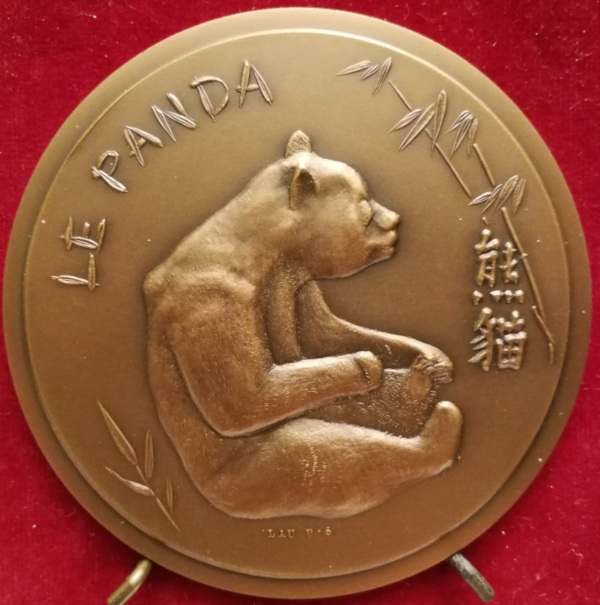
Po Shin Lau has been selected for the in-store publication of “Panda” – Front 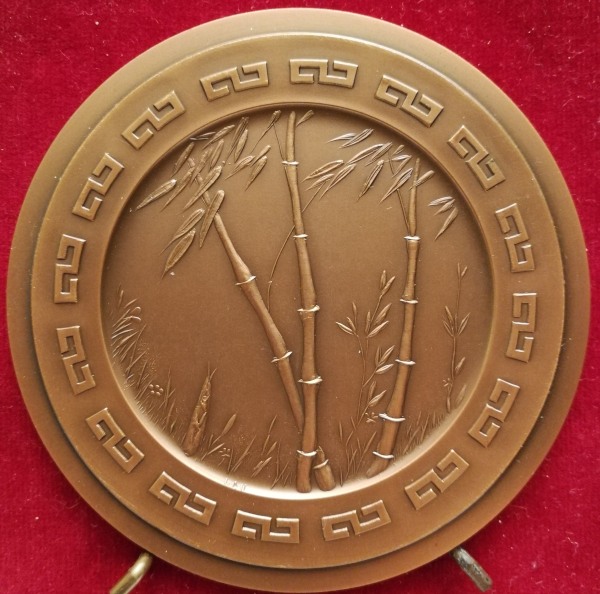
Po Shin Lau has been selected for the in-store publication of “Panda” – Back
Po Shin Lau is very proud and moved to have been able to design and engrave, during his two and a half years of internship at the Monnaie de Paris, a number of commemorative medals with Chinese cultural characteristics. Among them, “Panda”, “The Palace of Beijing” and “Zu Chongzhi” were selected to be in the art store of the Monnaie de Paris. In the century-old history of medals in Europe, the name of a Chinese artist appeared for the first time.

Immigration to Canada
When I entered Mr. Po Shin Lau’s apartment, the first thing that caught my eye was the etchings on both sides of the hallway. When I walked into the studio, there were ancient Chinese landscapes hanging on the walls and the bas-reliefs were placed on the table. On the easel, an oil painting landscape exposes the face of nature. This is where Mr. Po Shin Lau works and lives every day.

Po Shin Lau has been selected for the in-store publication of “Zu Chongzhi” – Front 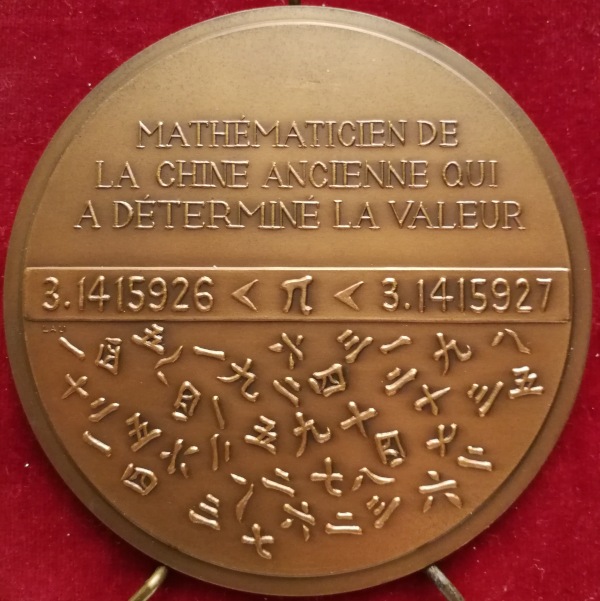
Po Shin Lau has been selected for the in-store publication of “Zu Chongzhi” – Back
The author has knowledge of Chinese painting and oil painting, but knows very little about etchings. Professor Lau took me to another room and showed me the etching machine he bought from Japan to Hong Kong and then shipped from Hong Kong to Canada, and patiently explained the process of making copper engravings. Then he carefully handed out two meticulous medals, one is a panda and the other is Zu Chongzhi’s bust, and spoke about his experience before immigrating to Canada.
The medal is often referred to as the “great bronze medal” in China, and Po Shin Lau believes that neither the “medal” nor the “great bronze medal” reflects its true artistic attributes. Therefore, based on the French pronunciation of “medal”, he gave an elegant name: Médallion to the latter.
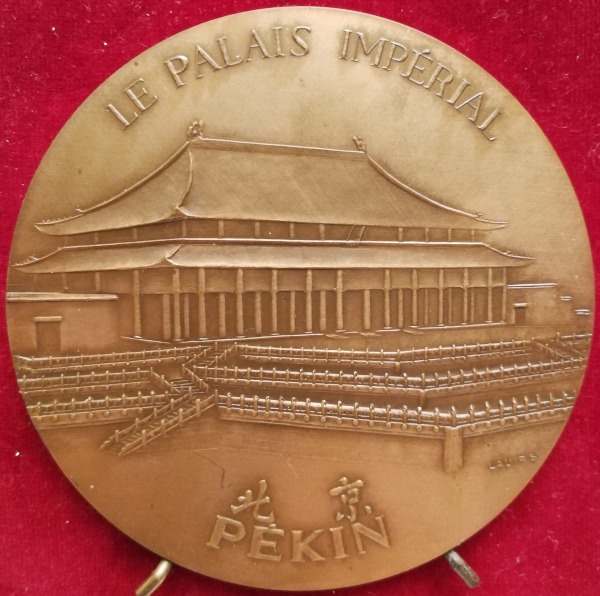
Po Shin Lau has been selected for the in-store publication of “Forbidden City in Beijing” – Front 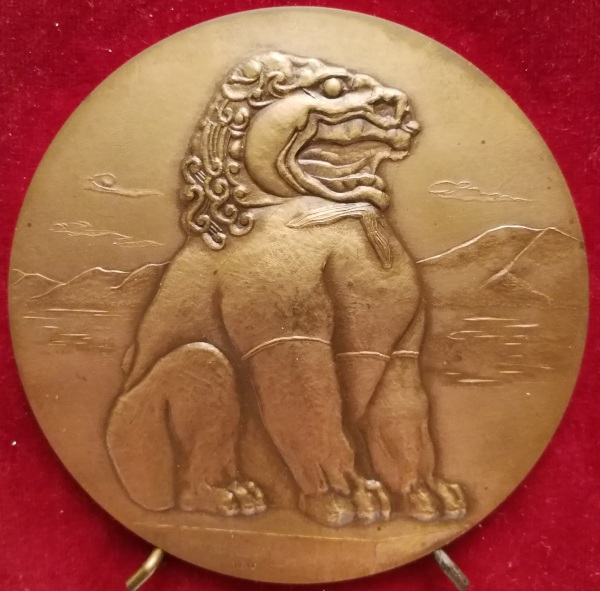
Po Shin Lau has been selected for the in-store publication of “Forbidden City in Beijing” – Back
In May 1979, Po Shin Lau took the three historically significant medals and happily flew straight from Paris to Beijing. He was going to take what he had learned, his knowledge, along with a steel mould, a set of carving knives and professional information learned in France to present to his home country after 17 years of absence. “1979 was the start of China’s opening up after the Cultural Revolution. Before going to Beijing, I contacted the China Mint Company in Beijing. I also brought their invitation letter to the Chinese Embassy to apply for a visa. But I got off the plane and called the China Mint Company. The response obtained was rather disappointing. The person who was to meet me had to go to Shanghai. So I was on my own to find a hotel. I took a taxi to the Overseas Chinese Hotel, but there were no more rooms available. I had no family in Beijing, and I carried a lot of luggage. I was very scared and felt helpless. Finally, I tried to call the French Embassy to find someone I knew from France. As soon as he learned of my situation, he drove to the Overseas Chinese Hotel to meet me. He then made arrangements for me to spend the night in his dormitory at the French Embassy, then took me to visit Beijing. A week later, I called and contacted the China Mint Company. In the following weeks, I got a warm welcome from the China Mint Company, they also hoped that I could stay, but I was still worried that I would not be able to adapt, so I decided to wait more before making a decision. “
Back in Hong Kong, Mr. Lau contacted the Monnaie de Paris and jointly presented an exhibition called “The Medals of France” with the French consulate and the Hong Kong Art Center, in order to present the techniques of sculpture, bas-relief of France, engraving, casting and several other techniques. Instant success! Hong Kong art lovers were pleased. Newspapers, magazines and television all interviewed Po Shin Lau. “According to my original plan, after the Hong Kong exhibition, I wanted to go to China to organize other exhibitions, but the response I got was to ask the Monnaie de Paris to pay the exhibition’s fees… As a result, the French consulate then turned to Taiwan to continue the exhibitions. I still think this is very unfortunate, as the items on display are all works of art of the French medals, and it is usually not easy to show them abroad. We lost a rare opportunity. This incident finally dispelled the idea of returning to work in my home country. “
After teaching art in Hong Kong for over ten years, Po Shin Lau immigrated to Quebec, Canada with his family in 1994. “My experience in organizing a medal exhibition in Hong Kong has helped me a lot for my immigration’s application”, he said. Three months later, Mr. Lau bought a house in the suburbs on the south shore of Montreal, life was very peaceful, his wife was busy with housework and his two children were studying, and he was concentrating on creating etchings. In 1996 and 2001, La Prairie City Library twice held “The Po Shin Lau Etchings Exhibition”. Mr. Lau’s etchings works have been selected five times for the annual exhibition of the Montreal Museum of Fine Arts.
Po Shin Lau discusses art
After the year 2000, due to bronchitis, Mr. Po Shin Lau ruptured blood vessels and vomited blood. He felt that his physical strength was not as good as before. After her two children went to university, they sold their original house and moved into the current building near the South Shore metro station. The apartment has two rooms that can be used as art studios. Floor-to-ceiling windows face the St. Lawrence Riverfront Amusement Park, which is full of light, open, and bright, and you can see the island of Montreal in the distance. Professor Lau has created a large amount of oil paintings and traditional Chinese paintings here, and his etchings which he loves so much is naturally not forgotten, especially on summer days when the window can be opened, he has always indulged himself in the world of the art of etchings.
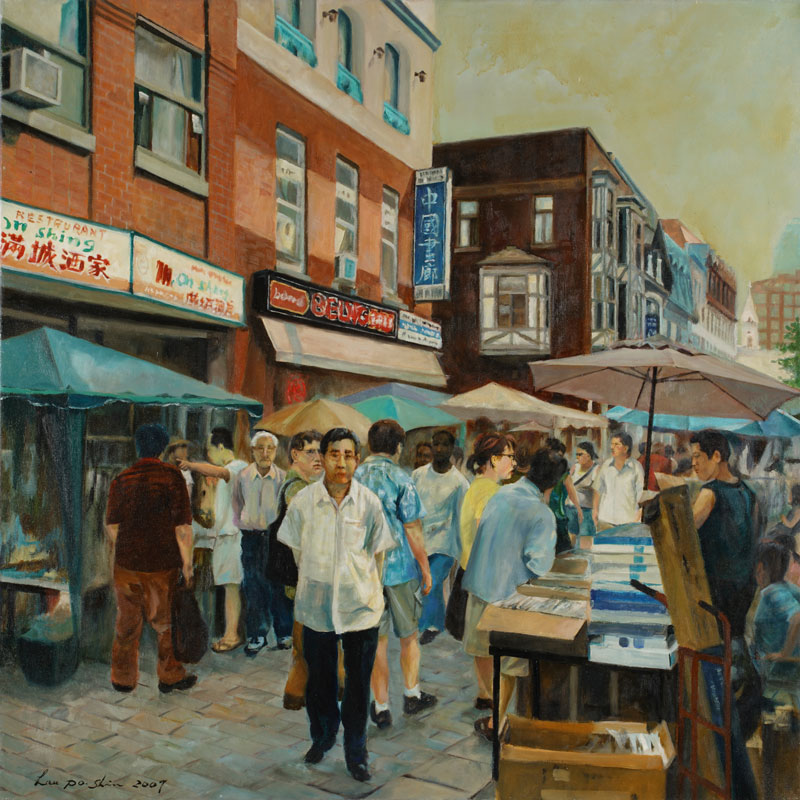
He said, “In 2007, I made a new attempt in the art of oil painting and created a collection of works on Chinatown. In 2009, a new change was made to my oil painting technique. I started using a painting knife instead of a brush to work. In 2015, we can say that this is a big step forward in my creative thinking. This is the result that I have been pursuing for decades. The image appears to be abstract, but it seems that I can still sense the realism, the poetic conception of a mystical world. It can give the viewer a space to imagine. The value of the work depends on this. “
Perhaps it is because the season for opening windows is not long in Canada. After all, the process of creating etching is harmful to the body; perhaps it is because of the unique charm of Quebec which lends itself better to expression in oil paintings. Po Shin Lau now creates oil paintings most of the time. Among his recent works, the author is the most moved by the thematic series of the Montreal Night scene: the headlights of the cars strongly impact the black blur, the windows of commercial buildings exaggeratedly show the prosperity of the day, and the couples holding each other hand wandering in the spring. In the dense streets, pedestrians holding cafes quietly cross the intersection in late fall. It should be the end of the city day, but you can’t see the slightest fatigue. The painter of the ancient years makes the nocturnal world bright and alive with his youthful spirit!
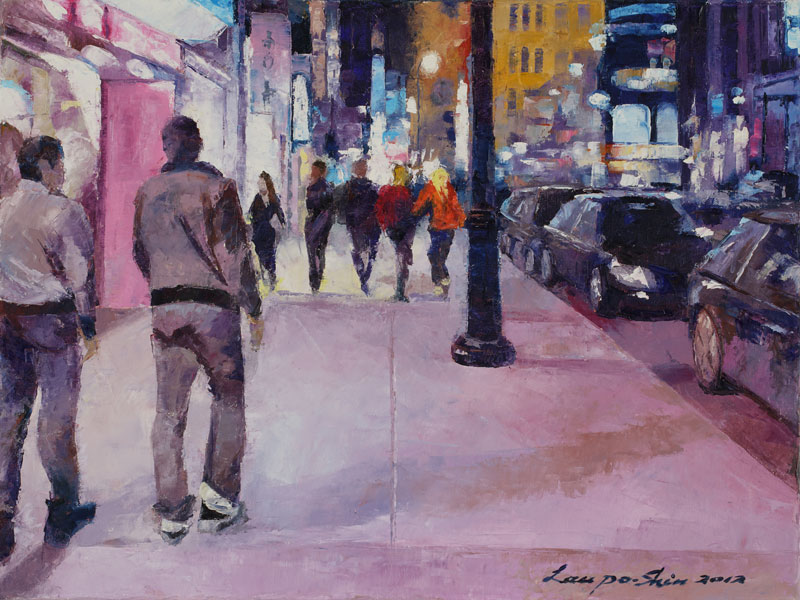
It can be seen that these works are a blend of the aesthetic appeal of Asia, Europe and America, and condense the essence of Chinese painting, oil painting and etching. “How did you create this?” I asked.
Professor Lau replied, “People who love to paint must love beautiful things. It is natural. Learning the art of painting is not just about learning some basic skills such as sketching, drawing, perspective, colour, etc., but also most importantly, you have to understand the true meaning of art and its spirit. Art is perceptual, and it becomes a drawing or a craft if it is too rational. When creating, an artist should paint as he pleases and express himself to the maximum. At least express his thoughts. Artistic creativity is very important, but it is only in the ordinary that its power and its characteristics can be demonstrated. In fact, it is not necessary to pay too much attention to any school or doctrine, whether it is modern or classical or whether it is avant-garde or conservative. I think the form does not matter. The appeal of a painting lies in its artistic charm. The artistic charm seems to be abstract in theory, but in fact it is very simple: a painting that can repeatedly catch your eye again and again is the charm of art. “
Po Shin Lau believes that although Chinese, European and American painting arts are different in tools, materials and shapes, their spirit is the same. For example, managing the relationship between virtuality and reality, such as emphasizing that the appearance of the mind is more important than similarity, simplicity is better than kitsch, and sensitivity is more than rational. Classicism and realism paintings in Europe and the United States are equivalent to the gongbi of Chinese paintings, which pay more attention to the rational. It is similar to the works of the Eight Eccentrics of Yangzhou during the Qing Dynasty, which emphasizes sensitivity. Due to the fast pace of life, modern people tend to aspire for quick success and quick wins, and like to deliberately create new artwork with strange ideas. In fact, the simple and unpretentious means of expression is based on the sketch, otherwise it will be impossible to show the artistic image and the deep connotation. Skills and ideas are therefore just as important. In reality, some students who graduate from art academies and art schools often have no technical problem, but the works are not attractive because they are limited by the teacher’s rules while many self-taught artists have remarkable works, because self-learning will not create according to the limits of others. In fact, the artist has spent his entire life studying on his own, accumulating experience, and expressing his feelings about life with his mastered aesthetic techniques.
He said, “We are more easily confused about how to choose themes. I think we should find familiar things in our lives. Art is expressing the most ordinary things in human life in simple themes. Ordinary, such as sun, moon, flowers, trees, mountains, rocks, rivers, lakes and other natural landscapes, sunny, rainy, windy and snowy climatic changes, joys, sorrows and the pains of people in life, various customs, etc. What the artist has to do is capture the characteristics, grab the viewer’s attention and move the hearts of people. No matter what genre or different styles, as long as it’s a work that can move people, it’s a good art. The so-called poetic and picturesque means that the painting must have a poetic feeling and a beautiful artistic conception, which will vibrate people’s hearts after seeing it and will not forget about it so soon. “
As the author expected, for the Montreal Night scene series, Mr. Lau did indeed bring his camera to downtown Montreal to capture the scenery. Mr. Lau said that nowadays painters who want to get started in creation usually collect information with cameras and sketches, the most important being to pay attention to the information needed for painting. The painter should have the basics of drawing so that he can use the pen flexibly and produce dynamic brush strokes, so that the image is vigorous, otherwise he will not be able to draw the mind, so deep skill is very important. In fact, drawing from photos is not about copying photos, but about taking photos as models, for reference. “The artist needs to activate and develop his own ideas until the completion of the work. It is also a creative process.”
Mr. Po Shin Lau said, “If in a person’s life there is no determination to do something, it will pass quickly. Some works that I thought were completed a few days ago, when I take a closer look, are in fact created two years ago. I have more and more the feeling of urgency; I do not want to waste any time. “
Mr. Po Shin Lau is very old and his body is not very healthy, but his artistic life is at its peak. He told the reporter that he was always inspired by painting from morning till night; he pointed out rows of works or semi-finished products and said, “The only way to rest now is: I’m tired of working on the etchings so I’m going to do Chinese painting for a while; I’m tired of doing Chinese painting so let’s do a few hours of oil painting…”
Fortunately, Mr. Lau’s condition does not look like what he says: “His eyesight is deteriorating and he is often unable to do what he wants.” The author feels that he is always full of energy and has a clear mind, just like his unfinished landscape painting; the oblique shine of the setting sun attracts boundless expectations and daydreams.
Created by the author in 2015
Publisher: Hu Hai (胡海)




